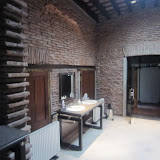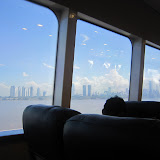Boca has a bit of a reputation for being one of the tougher areas in the city. While I'm certain that there are parts that one is best off avoiding, I'd spoken to a number of people who reported that the areas just off the extremely touristy El Caminito (little road) are perfectly fine, and in fact more pleasant. I probably wouldn't wander around there at night, but it was a lovely place to walk around on a Monday morning. Although El Caminito is full of the usual touristy schlock, the surrounding areas were downright tranquil. What's more, the look and feel of the place held firm, and in many ways felt more authentic.
An interesting thing about Buenos Aires that I hadn't really picked up on until my trip to La Boca is the role of direct-marketers in the street. Just as in New York and plenty of other places, one encounters an endless sea of people handing out flyers. And just as in New York, my initial instinct is to just ignore them--usually saying "no, gracias"--and keep walking. But twice today, Marty, Elizabeth and I found ourselves stopped to figure out where to go next, while standing immediately adjacent to one of these hawkers. And both times, after it became clear that we weren't going to take their flyers, they started talking to us. It turns out that they're extremely friendly--especially if you speak Spanish. One ultimately directed us to a lovely little courtyard parilla where we had lunch. I also got to try a proveleta, which is literally just a 5-inch diameter circular slab of grilled provolone cheese. I paired it with a salad of course. Sort of the Mitch Hedberg philosophy of eating. (e.g. "if you eat something healthy, the unhealthy stuff you eat with it doesn't count. It's like the lettuce says 'don't worry, he's with me.'") It was delicious, but definitely made me feel like I needed a nap.
Boca is also home to Boca Juniors, one of Argentina's two most popular soccer teams (along with River Plate*). Boca Juniors was the team for which Diego Maradona used to play, and they play in the famous La Bombonera stadium. La Bombonera, decked out in the team's classic blue and gold, is an architecturally interesting structure. When they built it, they didn't have enough room for a traditional bowl-shaped stadium. So it's as though they built one, and then just pressed it in from one side--one of the long sides of the pitch has vertically-tiered seating like boxes in an opera house. The stadium also houses the "Museum of Boca's Passion," which is the very excellent official name for the soccer museum.
At any rate, I was thrilled with the whole experience because I had been looking around for something that distinguished Buenos Aires from any other large city. For all I had heard of how European it feels, it seemed to be sort of a recreation of a generic European city, as opposed to its own unique entity. Having been to La Boca, I no longer feel that way. Although the touristy parts were almost Disneyesque, the historical authenticity of the neighborhood couldn't help but come through.
I should also add that yesterday I went to El Zanjón, which is a recent archaeological find. It was a mansion in the late 19th century, but the owners fled it during the yellow fever outbreak around that time. San Telmo, where the mansion was, was originally one of the wealthiest neighborhoods of Buenos Aires. But the threat of disease caused a lot of wealthy families to uproot and move to Recoleta, paving the path for that neighborhood to become the upscale home of dignitaries living and deceased. Excavations of the house also revealed a series of tunnels underneath that date to the 16th century, and which were part of the original canal system to bring water to the houses of settlers. Some historians speculate that the original settlement of Buenos Aires--both founded and abandoned in the first half of the 16th century--started in this area, and it's possible that these canals were part of it. Of course, this is yet another historical claim over which La Boca and San Telmo are in dispute--the Boquenses think the settlement was in their neighborhood at the mouth (boca) of the Riochuelo. I have no real interest in getting in the middle of this fight. So, I report, you decide, as it were.
Anyway, now I'm at a hostel in Puerto Iguazú, which is a base for a trip into the park tomorrow to see some of the world's most spectacular waterfalls. It is in the jungle, which means that in the first ten minutes that I was outside, I got bitten by about fifty bugs. Anyway, the hope is that I can get a visa from the Brazilian consulate, and see the Brazilian side tomorrow, and the Argentine side on Wednesday. Whether that will pan out remains to be seen. The park does apparently offer a great deal in terms of wildlife and natural beauty, so even if I'm "stuck" on the Argentine side, I'll be more than happy with that. Now I just have to figure out what to do about dinner. Preferably, it won't be a giant hunk of grilled provolone--I'm looking for some variety.
Saludos,
Seth
*River Plate gets their name from "Rioplata," the name for the region surrounding the Rio de la Plata--the river that runs between Uruguay and Argentina. Rio de la Plata actually means "River of Silver," an optimistic name chosen by Spanish explorers who were expecting to return home with ships full of precious metals. Therefore, "River Plate," the English term that is sometimes used to describe both the region and the soccer team (as well as Uruguayan and Paraguayan teams of the same name), is actually a mistranslation. Although, given that the explorers never did find any silver here, it probably makes more sense.
Fotografía:
 |
| La Boca |
 |
| El Zanjón |
 |
| Buenos Aires |












Hi Seth! Thanks for this post. I was actually on a hunt to find out the story behind the colorful buildings in La Boca, and your post answered my question. I mention you over on the nextstop blog, here:
ReplyDeletehttp://blog.nextstop.com/2010/04/la-boca-buenos-aires.html
Happy travels!
Josh